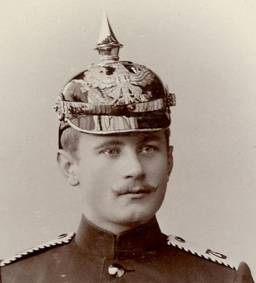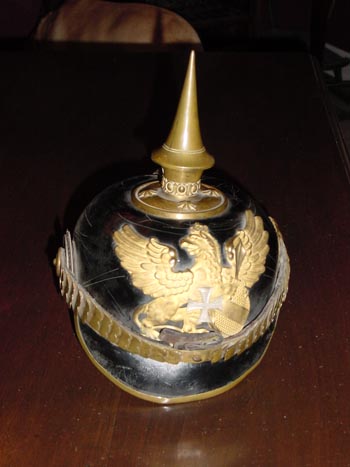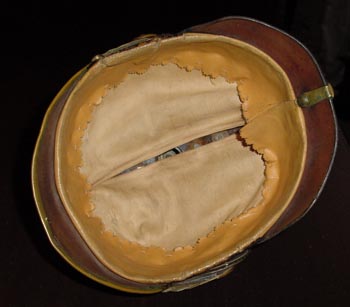One Year Volunteer (OYV)
Joseph P Robinson
June 24 2009

I have been tardy in rewriting this article. The original one was a bit confusing and I have learned more. We are only talking about 2 or 3% of the population. The vast bulk of citizenship did not have the social standing or the finances to join this crowd. In old photographs the one-year volunteer can be identified by the striped nature of the shoulder board edges.
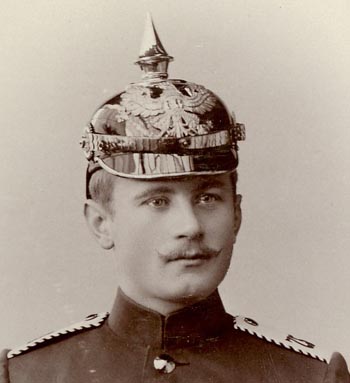
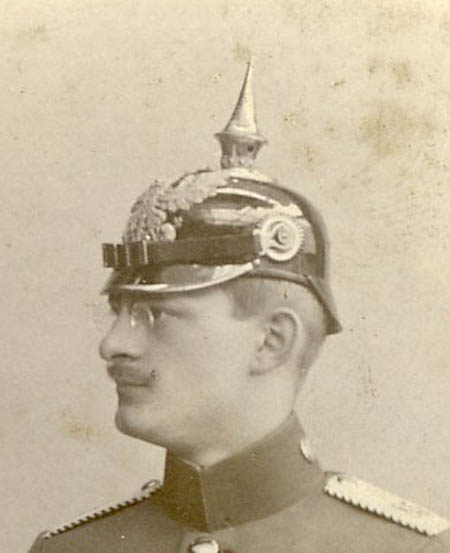
Based on a group of some poorly cited references that existed several decades ago, stories have been told and retold and handed down from collector to collector. Many of those stories are wrong. In the later decades of the 20th century there were few reference texts in the English language about pickelhaube. The volumes entitled The Pickelhaube by J. A. Bowman Imperial Publications, 1989 and 1992) and Pickelhauben, by Eric Johanson (H.S.M. Publications, Independence, MO, 1982), were the choice references in English. These broadened collectors understanding and created a foundation that many collectors still base their beliefs on. I call that conventional wisdom.
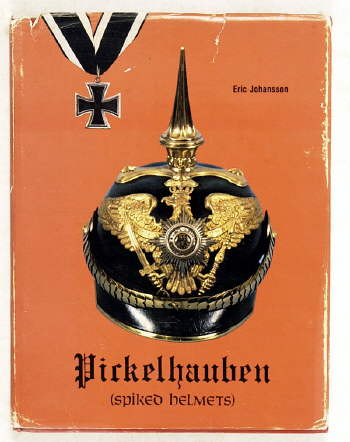

Conventional wisdom puts helmets into three categories. Officer, enlisted (OR), and everything else is identified as a One Year Volunteer (OYV). It is how I learned and questioning what I was told led to this research. The famous book by Johansson does not list Fähnrich or OYV in either the glossary or index i.
Many collectors didn’t even understand the term, “one-year volunteer” (in German, “Einjährig-Freiwilliger”). If a helmet had a mixture of officer and other ranks parts, it was identified as being a one-year volunteer helmet. To many collectors it had long been common knowledge that OYVs would become officers at the end of their year and possibly change helmet parts over time to show their new status. Eventually the officer might move to the reserves or the landwehr. References came out showing the Allerhochsten Kabinettsordres (AKOs) changes to officer and other ranks helmets. Many collectors decided that anything that didn’t fit these AKOs was a one-year volunteer helmet.ii Much of this understanding is wrong.
Everyone who could afford it became a one-year volunteer – wrong, wrong, wrong.
The education system in Imperial Germany was significantly different than American understanding. The vast bulk of the common population attended a free Volkschule. This ended at age 14. Only a very few had the family resources to continue on and fund the education.
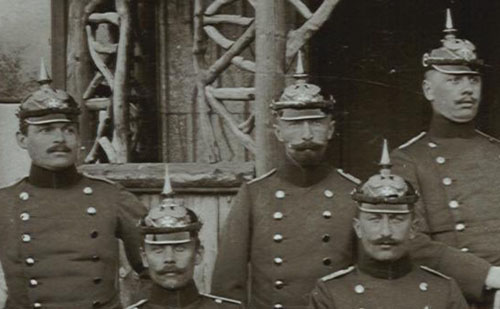
Receiving a reserve commission was the most sought-after goal of students, even those with the Abitur. There was a huge difference between a regular officer and a reserve officer. Reserve officers sometimes tried to pretend they were regular officers but they were not. Considering that you had to do universal military service time, the law gave the educated student a way out. Young men who had earned their One Year Certificate could elect to serve just one year of their compulsory military service on active duty to avoid delaying their university education or other employment. This does not equate exactly to American school understanding. A One Year Certificate was actually earned at the end of the Untersekunda year through an examination. Students in the six year school could take this examination as well as students after their sixth class of the nine year school. Only one third of those eligible and possessing a one-year certificate continued on into the military. Most were discharged being found not physically fit. (It is not the intent of this article to discuss eligibility, acceptance or Musterung.)
There were two different types of Freiwilliger; multiyear and one year. Multiyear Freiwilliger were basically enlistees. Given an application to a specific unit substantiating parental permission, and the family’s ability to do without them, they could apply for two, three or four year status. The Unteroffizieres would vote to accept them or not. This was not comparable to a one year volunteer and the family did not pay for the equipment and sustainment of this kind of a volunteer. While much understanding goes into the volunteers 96% of all soldiers were draftees.
Religion played an important part in the acceptance process. It is instructive however that in 1913 almost 46% of all Jewish soldiers were one year volunteers. This is as compared to 2% of the Protestants and 1.5% of the Catholics. Here you have the Jewish soldiers being of higher social standing than many of the common soldiers creating a resentment. iii.
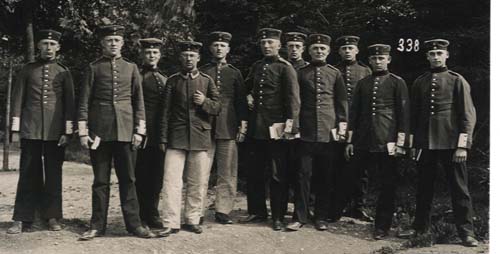
One year volunteers became officers – wrong, wrong, wrong.
Some one-year volunteers became officers. The OYV could become an officer aspirant in the reserves if he wanted to, was recommended by his active company commander, and passed or requisite tests at the end of his year of service. If the one year volunteer did not meet all these criteria he could be passed into the reserves as a normal OR or as an aspirant NCO. If all of the criteria were met, he would become an officer aspirant in the reserves and promoted to supernumerary Unteroffiziere if he was not already at that rank. The officer aspirant was intended to go to two different training sessions. One session per year after he took the aspirant test and left active duty. While only two sessions were required, these were normally accomplished over a period of several years. In some cases this took quite a few years and commissioning was delayed until the ages of 27 or 28. During this first session, he was instructed on how to be a platoon leader and took a test at the end of the eight week session. If the individual passed this test, he would be promoted to Vizefeldwebel. iv.
Of those completing their one year only every second recruit was recommended by the company commander as a potential officer. One third of those who entered military service went on to become reserve noncommissioned officers. And 13% were discharged without any promotion. v. A Bavarian army example in 1906 showed that 43% of the one year volunteers left service with the recommendation of the company commander. Of that group only another 43% or a total of about 18% of the 1906 one year volunteer intake, actually received a reserve officer commission. vi.
One-year volunteers were like officers – wrong, wrong, wrong.
OYVs were neither officers nor officer aspirants. They were OR types. They were enlisted men. Fritz Nagel was an OYV. In his 1962 memoirs he detailed his position as a OYV. “And nobody spoke to us. In our battery we were five one year men completely separated socially from the others. We were still considered common soldiers.” vii. Yes, they were different and privileged and after time they could become officers but calling a OYV an officer and looking at them that way is wrong.
A one year volunteer (OYV) had to equip themselves (rations, quarters, uniforms and equipment). They had to pay for it all to include a horse (if needed) or had to pay into the remount fund. The cost was pretty substantial. It was considered to be generally equal to the cost of a year at university, and very much dependent upon which kind of unit a one year volunteer decided to go into. He could choose his regiment; however, infantry, jägers, engineers, and foot artillery were expected to pay between 1750 and 2200 marks for their year. Field artillery and train increased the cost from 2300-2700 marks. But for cavalry and mounted field artillery, the costs soared to 3400 to 3600 marks a year. viii.
The payback was.
1. The OYV only had to do one year of active service before being transferred to the reserve. This was in place of the 2-3 year active requirement.
2. The OYV could start military training at age 17 at the earliest. The normal guy, who was more like a draftee started at age 20.
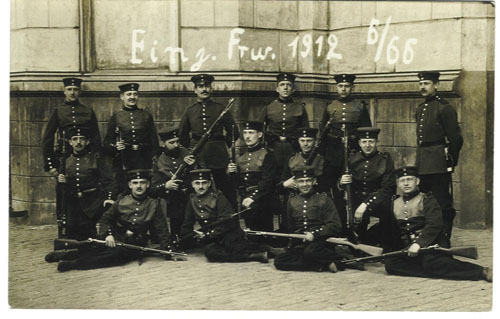
OYVs could join the service with their class on the first of October each year. They were grouped together with the other one year volunteers and their training was separate. Often their training consisted of only a few hours a day.ix. After three months they could be put into a special course, and after six months, if all went well, they could be promoted to supernumerary Gefreiter. The best of the class after nine months, could be promoted to supernumerary Unteroffizier. All this talk about supernumeraries is a reinforcement of the understanding that these guys were extra or supernumeraries to the establishment. One year volunteers were sometimes allowed to eat in the officer’s mess. Not with the officers of the regiment but in a separate room. x.
There was a conscious class distinction between the one year volunteers and the “common soldiers”. Not only was the training separate but the one year volunteers were from a higher social standing. The only way the “common soldiers” got back was to require the one year volunteers to buy a round of drinks. For many of the one year volunteers military life was the first time they had come in contact with the lower levels of German society. One of the most common ways to differentiate these classes was that the one year volunteers refer to each other using the formal “Sie”. Lower-class soldiers also use this form of address for one year volunteers. “Common soldiers” used the more familiar “du” when addressing each other. xi.
Medical OYVs were yet different with a 6 month OR requirement in the active force and they jumped to full commission in the Medical department for the last 6 months as an Assistant doctor, Einjahrfrewilligeartz. xii.
The uniform equipment of the one-year volunteer required everything to be purchased privately wrong wrong wrong.
All of the four armies of Imperial Germany followed this basic method. one-year volunteers had to pay the unit for their service. Additional equipment and uniforms could be taken at their own expense and risk. You need to read in detail first this section of the army order. Then read the further clarification in one of the one-year volunteer manuals. This one is particularly clear even though it is specific to the field artillery.
Attachment 2 to § 19 of „Heerordnung“
Uniform, food and equipment of one-year volunteers
1. Any OYV has to buy the required pieces of equipment and uniform out of his own money. During their one year of service they have to care about food and accommodation by themselves during peace-times.
Pieces of equipment including horse-riding equipment are supplied by the respective military unit against payment of an annual compensation for use, wear and tear of such equipment. Weapons shall be supplied under the condition of due care by the OYV who has to keep them in proper and serviceable condition and who has to hand them back after leaving active military service.
2. If a OYV is using his privately purchased uniform he is doing so under the risk that his unit may refuse this uniform in case it is not properly manufactured according to military specifications.
Any OYV therefore may be interested in purchasing his uniform and equipment through the Garment Committee (Bekleidungskommission) of his unit against paying the officially budgeted prices (Etatspreise).
3. If a OYV may find himself in the difficult position to officially declare that he won’t be able to further financially support himself during his remaining period of service and if it doesn’t seem to be justified to support him granting free access to free meals and accommodation through his unit according to § 94,12 of the “Wehrordnung”, he may lose his status of being a OYV and therefore will not be transferred to reserve status after one year of service. Costs incurred by purchasing uniforms and equipment will not be redeemed in such case.
4. Any pieces of uniform remain being property of the OYV after regular discharge (after regularly being transferred to reserve status). Pieces of equipment have to be handed back to the military unit.
5. In case of mobilization a OYV will be fed and equipped on expenses of the army like regularly enlisted men. Field serviceable pieces of uniform in the property of the OYV can be kept and used; garrison serviceable pieces may be transferred to the respective “Ersatz” unit; in both cases the estimated value has to be paid to the OYV by his unit. Any compensation paid by the OYV to use official pieces of uniform and equipment shall be redeemed by his unit of the first day of the month in which mobilization was ordered.
6. Upon demobilization the OYV shall hand back all pieces of uniforms and equipment he has received from his unit. If they are not transferred to reserve status upon demobilization the OYV again has to care for uniform and equipment by himself. If he would like to keep pieces of uniform and equipment after demobilization he has to refund the respective estimated value to his unit.
| Wernigk, Major and battalion commander in FAR 57 Handbook for OYV of the field artillery 11th edition, E S Mittler & Sohn, Berlin 1908 I Uniform and equipment, horses, food and accomodation of OYVs 1. OYVs have to purchase and maintain uniforms and equipment on their own expenses. If it may be assumed that of each piece of uniform, except the coat where just one piece will be sufficient, two pieces will be required, the estimated value of the uniform pieces supplied by the regiment will be 129.40 M = approximately 130 M All pieces of uniform paid that way shall become personal property of the OYV. Extra pieces Estimated need of repair Additional costs Total costs of uniform and equipment for a OYV are as follows: Uniform pieces supplied by unit 130,– M Altogether 784.55 M of costs of uniform and equipment of which 134.55 M had to paid to unit right at the start of the one year service. |
One year volunteers with thick visor trim helmets.

The Helmets (you will often see Fähnrich helmets and one-year volunteer helmets advertised interchangeably – later you will see that the helmets were pretty much identical) The reader should be cautioned that the helmets attributed to one year volunteers could also have been bought by a simple private, simply a purchase which adds to the confusion.
The one-year volunteer had to buy their own helmet ( private purchase or Eigentums helms) amongst other items. There were in general three different kinds of helmets. One-year volunteer helmets are easily identified by having some or most of the “officer” embellishments – but not all. There does not seem to be any specific guidance as to which “officer” embellishment would be added or not and one-year volunteer helmets vary greatly. It seems as though the driving force was how much you were willing to pay for the helmet. Cockades size does seem to have mattered.
The first kind of helmet is one bought by a one-year volunteer from a retail vendor for the purpose of being a dress helmet. If the individual was going to go on to be an officer, this type of helmet could be converted by the retail vendor in to an officers helmet. These are the most commonly found helmets—and also the ones that are changed the most. Unfortunately some collectors look at these helmets and say: “Gee there is something wrong with this – if I just change this one thing, I can fix it and return it to being an officer helmet.” Remember that only 18 to 20% of one-year volunteers ever became officers – reserve officers.
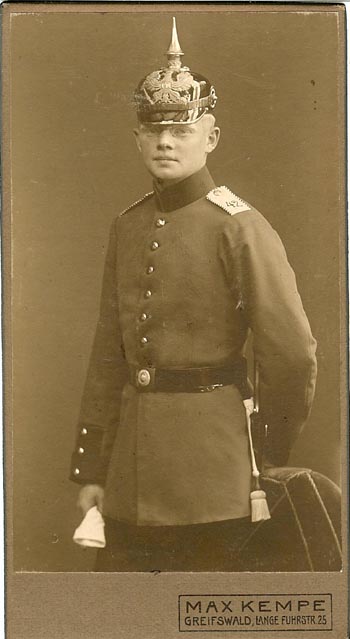
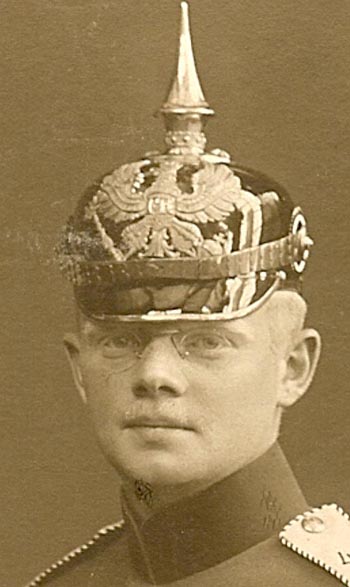
Let’s look at the standard one-year volunteer type helmet. This one, from Bavaria, offers a mixture of parts that can confuse some collectors. The front visor trim is thin, the rear spine and the liner are clearly officer quality. There is no pearlring, the chin scales are clearly for enlisted helmet, the front visor trim is round, and the spike base is round like an enlisted helmet. It has enlisted 48 mm cockades. So this is an enlisted helmet with some fancy upgrades. A classic non-converted one-year volunteer helmet. It could also be a helmet use by a standard private and purchased by that individual.
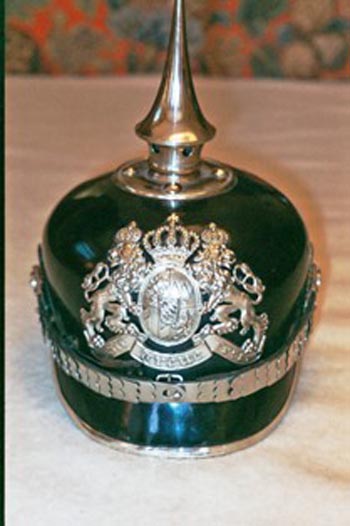
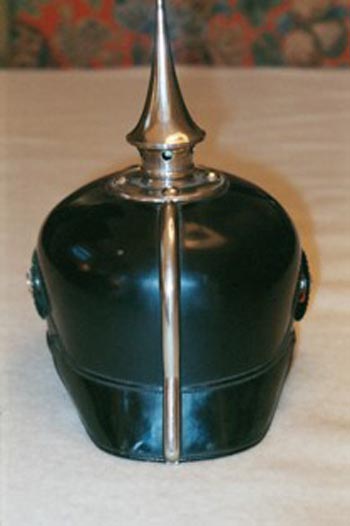

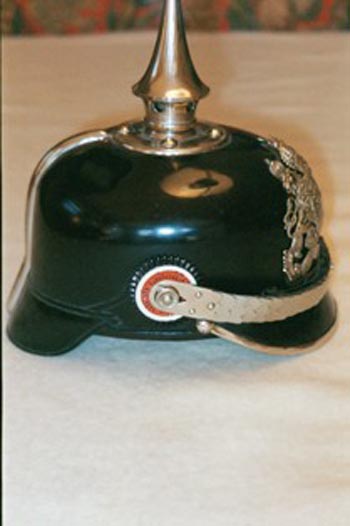
The second kind of helmet is called a Diensthelme—or service helmet. These were a lower quality helmet used for everyday use and were as a result less expensive. The most identifiable parts of these helmets is that regularly the visors are leather colored underneath, and they often have a thick visor trim. A Diensthelme could and often would be converted should the one-year volunteer become an officer. These are found in many varieties to include leather liners as well as a more traditional officer style liner.
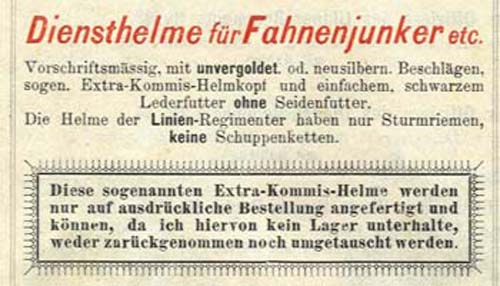
The Baden helmet pictured below is a classic Diensthelme. Private purchase, fully converted to Officer grade. That telltale sign of the conversion is that the undersides of the visors are leather color. Many retailers during that time put disclaimers in their catalogs that said they would not be responsible for conversions.
The third kind of helmet is an issue helmet use by one-year volunteer. These were literally rented from the unit for the year and had to be returned. It seems as though everyone had one. They are often found as a normal enlisted helmet complete with depot marks but then having a owner’s tag identifying the owner as a one-year volunteer. As the one-year volunteer was supposed to buy all of his equipment, it is not clear how the one-year volunteer ended up with the issued helmet. The two possibilities seem to be that the company actually issued them some of their equipment or that the one-year volunteer was allowed to buy issue equipment for their own use. As a subset to the first idea, it is possible that issue helmets were used during reserve and Landwehr call up times for training. A soldier could then stick a personal tag into the helmet.
Let’s look at an example. This helmet is clearly for the Guard Train Battalion. There are depot marks, a wide visor trim, enlisted chin scales and spike. Yet it is clearly identified as a one year volunteer.

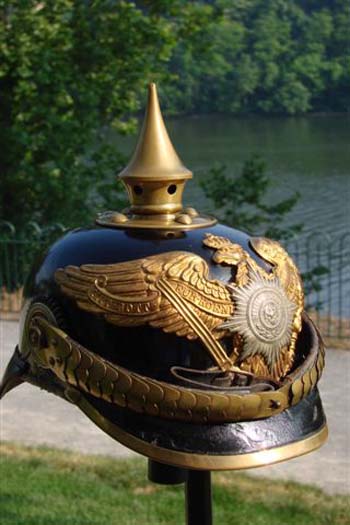
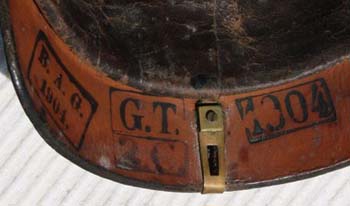
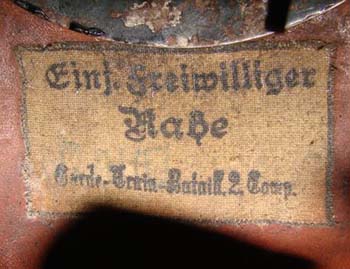
Conversions
Clearly not all helmets had to be converted. If you had no desire or ability to become an officer why bother? A one-year volunteer that did not go into the commission ranks of the reserves still did their reserve time just like a normal draftee. Still considered something special – these more educated soldiers often ended up doing administrative functions.
Those that were to go on to commission had to make several decisions. Should they get new helmets? Very expensive but very nice and often given as gifts to the new officer. For a far less cost the helmet could be converted. Much of this could be done by the owner himself. For instance, star studs, cockades, and a reserve cross could be upgraded at minimal cost.
Some conversions were significant. It is a monument to frugality that Bavaria and Württemberg converted helmets. For those two kingdoms the spike base itself and the visor had to be changed. Officer helmets had cruciform spike bases and squared front visors. One-year volunteer helmets for those kingdoms had round spike bases and rounded visors. Let’s look at an example that clearly shows old holes left over from a round spike base.
This is a fully converted helmet from the Avery collection. A wartime M15 officers variation that still has the telltale holes from the older round spike base.
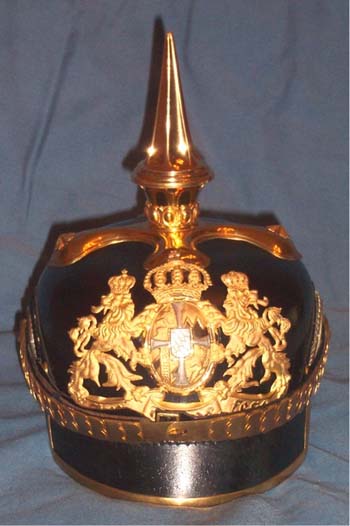
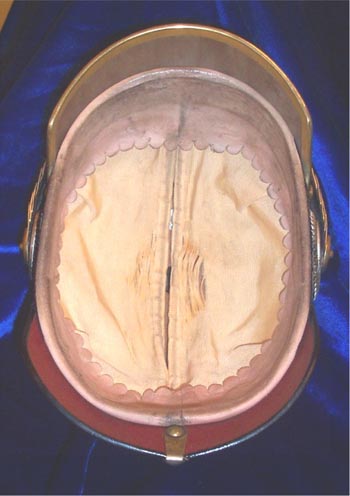
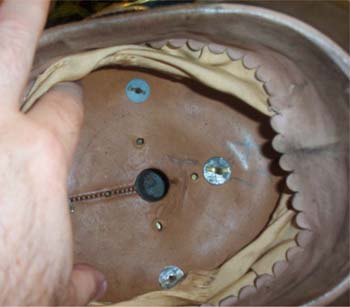
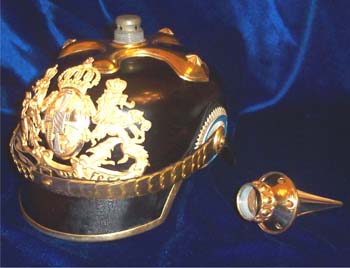
The helmet above has a nice reserve Wappen with a Landwehr cross. This is totally consistent with a reserve officer. The one-year volunteer however chose what ever regiment he wanted and in peace time there were no reserve units to choose from. So the one-year volunteer helmet would be an active Wappen. Then during the change, as a reserve officer he would add a cross. This necessitated plate changes in many cases. As a result, many double holes were caused by the conversion of active one-year helmets to reserve officer helmets. Finding a helmet with double holes from a former one-year volunteer should not be a showstopper. However, most collectors think all double holes are bad. This picture shows the double holes from the helmet above.
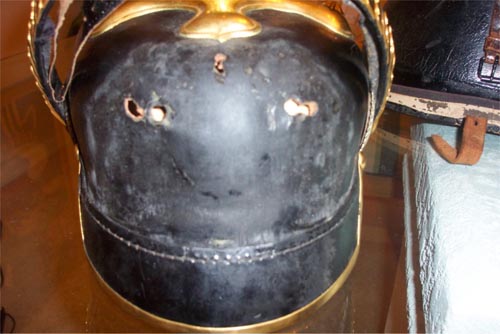
In addition to the holes there was often a problem with the Wappen themselves. For instance, the Baden plate for a reserve officer had no motto. The motto itself was found on the Landwehr cross. An active Wappen for a one-year volunteer should have a motto on the bottom of the Wappen. When converting the one-year volunteer faced a choice. Buy a completely new Wappen with out the motto or just spend a few cents to buy a cross and attach it to the old Wappen. Various forms of attachment and mottos are found on many converted one-year volunteer helmets. The Diensthelme from Baden shown above has the correct Landwehr cross attached to a formerly active Wappen with motto. This Landwehr cross is only primitively applied. As to be expected without a Wappen change there are no double holes.
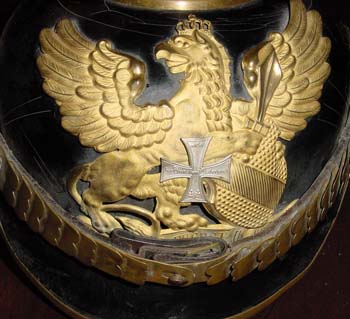
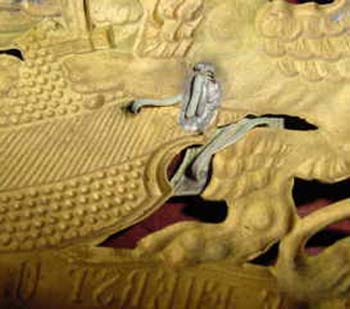
Metal Helmets
There were one-year volunteers in the units that had metal helmets also. And while these were expensive they could also be converted.
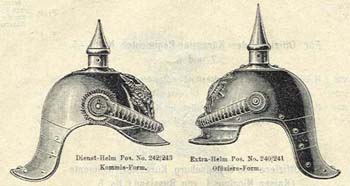
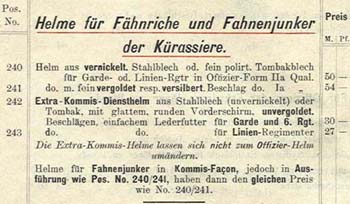
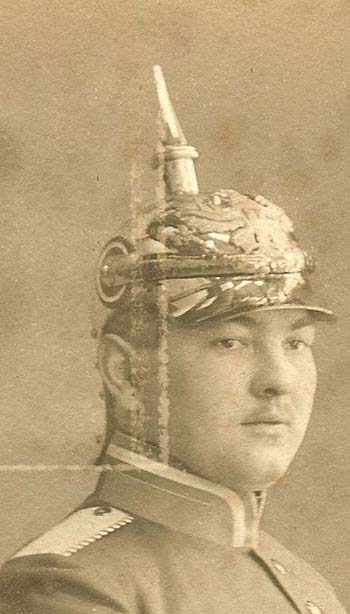

The Individual States
Some states had some very distinct issues when dealing with one-year volunteer helmets and their conversion to officer helmets. Remember the one-year volunteer was in an active unit and therefore there was no Landwehr cross. The one-year volunteer got a reserve commission. Therefore he needed a Landwehr cross.
Baden From the Baden example above you can see that Baden’s significant difference comes from the motto on the Wappen. Absolutely correct would have no motto on a reserve Wappen only the motto on the cross. Many if not most Baden reserve officer Wappen have both the motto on the Wappen and the cross.
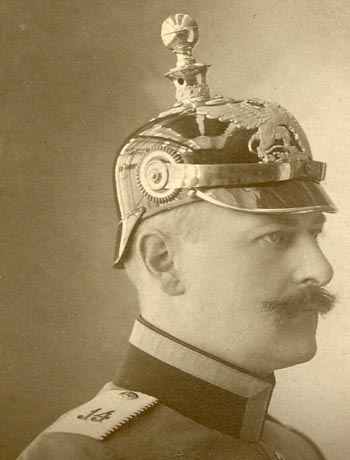
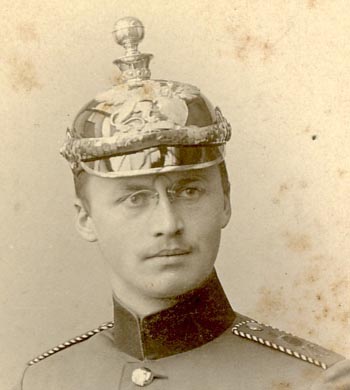
Bavaria There were significant differences between a one-year volunteer helmet and a commissioned officer helmet. The one-year volunteer had to replace both the spike base as well as the front visor. One-year volunteers also needed a reserve Wappen.
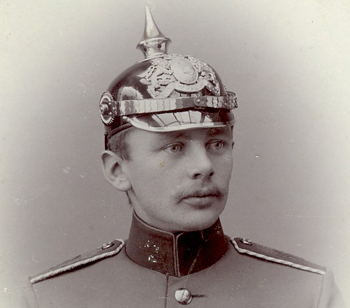
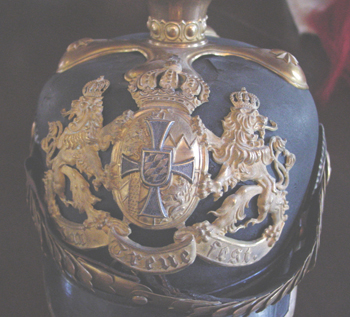
Hanseatic States Only the cockade need to be replaced in addition to the upgrades needed to make it officer helmet.
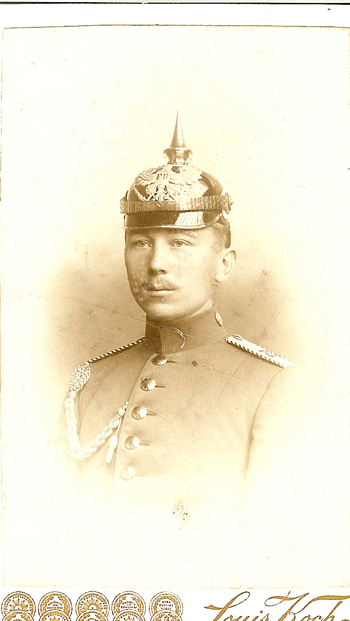
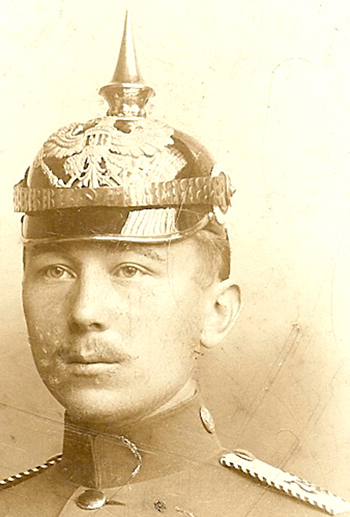
Hesse These were always significantly different anyway. Photographic evidence seems to show these helmets being more officer like requiring few upgrades.
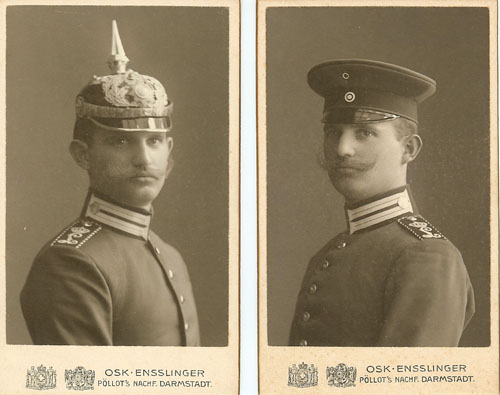
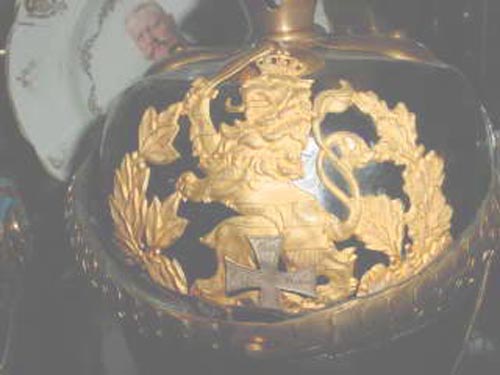
Mecklenburg In addition to any upgrades required for the officer helmet, the one-year volunteer needed to add a Landwehr cross to the Wappen.
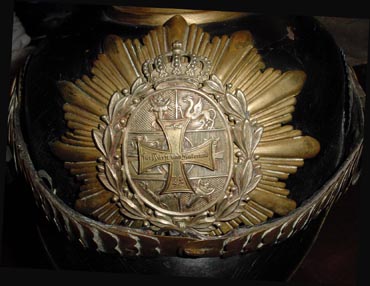
Prussia In addition to any upgrades required for the officer helmet (which could include adding enamel – or a whole new Wappen), the one-year volunteer needed to add a Landwehr cross to the Wappen. Absolutely correct would have no motto on a reserve Wappen only the motto on the cross. There was a different reserve Wappen from the active Wappen. The reserve Wappen had no motto but a large FR on the chest of the Eagle. Landwehr crosses are found on both kinds of Wappen.
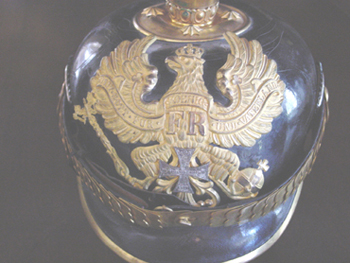
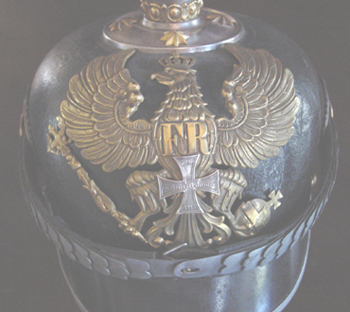
Prussian States Those states such as Oldenburg, Brunswick and the Thuringian States generally follow the same rules as Prussia. However, there is still controversy whether in all cases the distinctive crest of the state covered an FR or existed on a Landwehr eagle.
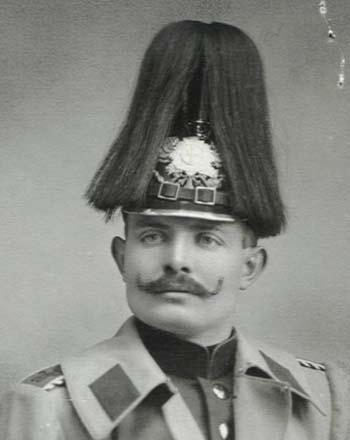
Saxony In addition to any upgrades required for the officer helmet, the one-year volunteer had to replace the Wappen from an active Wappen to a reserve Wappen with a built-in Landwehr cross.


Württemberg Similar to Bavaria, There were significant differences between a one-year volunteer helmet and a commissioned officer helmet. The one-year volunteer had to replace both the spike base as well as the front visor. The one-year volunteer could add a Landwehr cross to the existing Wappen.
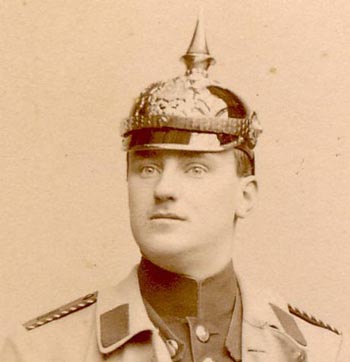
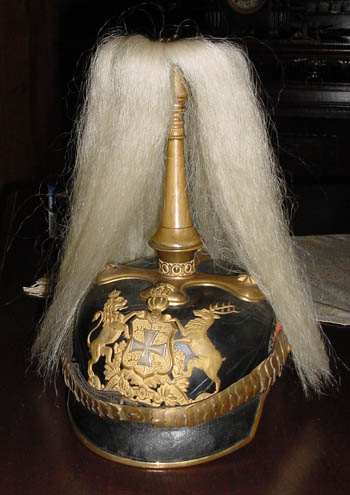
The Fähnrich
Over the last couple of years, there have been some changes to “conventional wisdom” as Fähnriche helmets have been rediscovered. xiii. Of course, there is no equivalent to Fähnrich or ensign in the U.S. Army so collectors had to stretch their knowledge base to comprehend this rank structure. “Conventional wisdom” had it all wrong. Even the recent volume, Imperial German Military Officers’ Helmets and Headdress 1871 by by Thomas Stubbs (Schiffer Publishing, Atglen, PA , 2004) included the incorrect premise that Fähnrich helmets were the same. xiv.
The commissioning process is covered in another article. However, from a helmet perspective they are in most ways identical to OYV helmets. Officer aspirants were either a Fahnenjunker or a brevet Fähnrich. Then you became a Fähnrich in conjunction with the Kriegschule, then you became a PortapeeFähnrich (or DegenFähnrich) if you passed the Officer test. At this point he could wear officer cockades. Up to that time OR cockades. In 1899 we confused everyone by just calling all Fähnriche– Fähnriche.
Only Fähnrich that had passed the officer exams wore officer cockades. OYV xv. and early (non-test taking) Fähnriche wore OR cockades. Helmets for all Fähnrich and OYVs wore Eigentums helms and had mixtures of officer and OR items. The only thing you can tell is that officer cockades = upper level, test passing Fähnriche and OYVs had OR cockades. You cannot tell between OYV and lower level Fähnrich.
Other Headgear
There were one-year volunteer headgear for all of the different kinds of headgear. There is no intent to cover all of them in this short article.


Private Purchase Studio Photos
There are many studio photographs of privates who are not one-year volunteers that have private purchase helmets. This was allowed. However, it is not clear if these helmets belonged to the individual, the unit, or were a photographers prop.
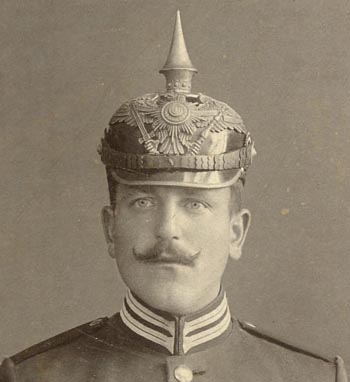
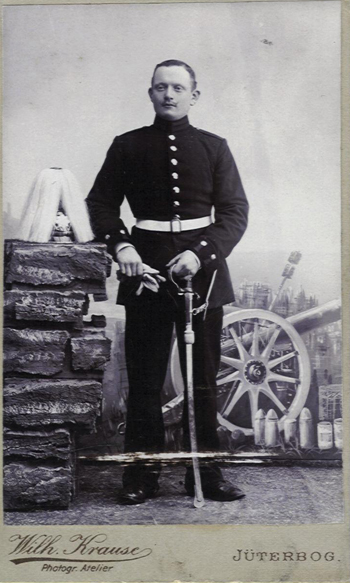
OYV helmets have been the bane of people fighting fakes and doctor jobs. This is compounded by Stubbs rightfully including “bad” helmets as “good” in his recent text. xvi. The recent book by Charles Woolley focuses on the difference between regulation and field use. There are several Fähnrich helmet pictures in the Stubbs book which can be grist for thought. Pg 96,148, 187, 188, 290, 291, 300, 301, It is instructive that this recent book changes the conventional wisdom but does not “fix” it. There are no OYV helmets shown in that book, only Fähnrich. I point to the caption for the helmet on pg 148. “Helmets of Fähnrich were normally fitted with officer cockades.” Tilt.
- Johansson, Eric, Pickelhauben, H.S.M. Publications, Independence , Missouri , 1982. pg. 175-180.
- Bowman, J.A., The Pickelhaube Volume 1, Line Infantry, Imperial Publications, Lancaster England 1989 pg 26-49.
- Exner, Moritz, Der Weg zum Einjährig-Freiwillinen, Verlagbuchhandlung von F.F. Weber, Leipzig, 1897
- Frevert, pg 159-160
- Frevert, pg. 225.
vii. Nagel, Fritz, Fritz,Der Angriff Publications, Huntington W. VA., 1980 pg 11.
viii. Exner, Moritz, Der Weg zum Einjährig-Freiwillinen, Verlagbuchhandlung von F.F. Weber, Leipzig, 1897, pg 102-104.
xii. Stubbs, Thomas N.G., Imperial German Military Officers’ Helmets and Headdress 1871, Schiffer Publishing, Atglen , PA , 2004, pg 32.
xiii. Robinson, Joseph P. , Colonel J’s Imperial German Pickelhaube Musings, Colonel J’s LLC, 27 March 2004.
xiv. Stubbs, Thomas N.G., Imperial German Military Officers’ Helmets and Headdress 1871, Schiffer Publishing, Atglen , PA , 2004.
- Bowman, J.A., The Pickelhaube Volume 1, Line Infantry, Imperial Publications, Lancaster England 1989 pg 74 states OYV wore NCO cockardes. I think this is fantasy as I can find no AKO backing. One of many Bowman mistakes.
xvi. Stubbs, Thomas N.G., Imperial German Military Officers’ Helmets and Headdress 1871, Schiffer Publishing, Atglen , PA , 2004, pg 174 for example.
There are many people who contributed to this article. There are helmets from the collection of Steve Flanders, Bruno Peault, Mark Avery, Randy Trawnik and the author. Frank Buchholz translated the two different articles. The pictures of Brian Kostel and Max Chaffote are located in the article. If I have forgotten a contributor it is an accident and I will correct it. Please let me know.

